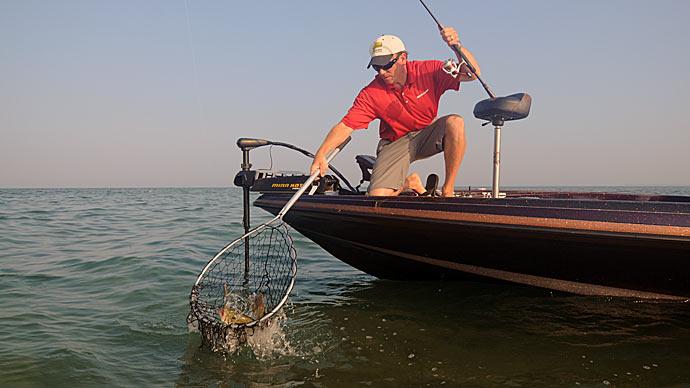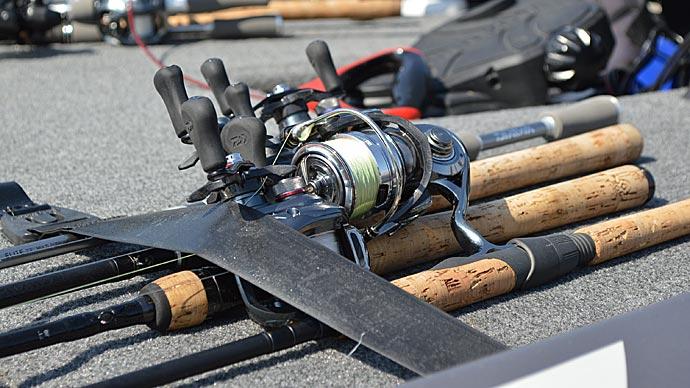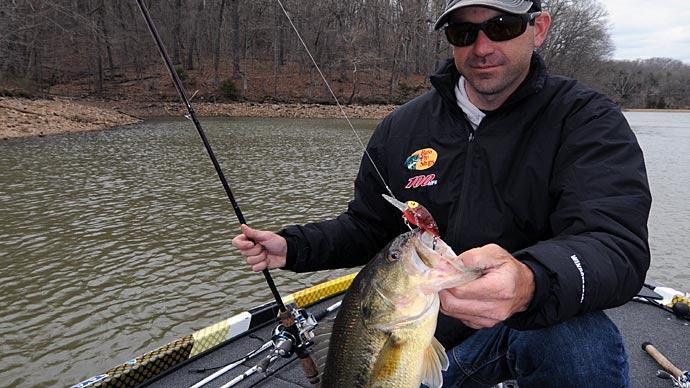
Think like a golfer when choosing rods for bass fishing.
A good golfer carries several clubs and picks each one for a specific situation, whether it’s driving for distance or finessing a chip shot. Today’s angler should use the same approach.
To accommodate most fishing situations, an angler needs at least five rods. Here are the rods I believe you need to cover the basics:
Spinnerbaits: I want a short rod for putting spinnerbaits in tight places. The choice these days is a 6-6 medium-heavy to heavy action casting rod. Most anglers prefer longer handles, but those tend to catch on the forearm when making roll casts to logs and bushes. The straight handle works great for overhand casts in open water. Try fishing with a rod that has a shorter handle. Doing so allows for better rod and lure control when making targeted casts to shallow cover. Years ago I would fish with a 5-5 rod with a pistol grip when fishing tight places. If you happen to have an old 5-5 rod (not many companies make short rods these days) give it a try.
Crankbaits: You need two 7-foot rods for crankbait fishing – one for deep-running baits and another rod with a softer tip for lighter, shallower-running baits. The softer tip model allows you to “load” the rod better and make longer casts with lighter lures. However, if you try to throw heavier crankbaits on that rod, the tip absorbs all of the energy and you get less casting distance. Also, the beefier rod will function as your Carolina rigging rod.
Both rods should be parabolic, meaning they bend evenly from tip to butt. That was my primary concern when I worked with Berkley to design the Hank Parker Signature Rods. Rods that stop bending halfway down the blank make casting more difficult. Such a rod is also too stiff for landing big fish on crankbaits.
Rod length depends upon the individual, but 7-footers provide better leverage and casting distance. If you’re a shorter person, say under 5 foot 9 inches, you may be more comfortable with a 6 1/2 –foot rod for crankbaiting.
Flipping: The heavy action, 7-foot flipping rod is a necessity on lakes with a lot of shallow cover. It provides power for moving big fish out of thick stuff, and enables you to reach targets in tight quarters away from the boat. My flipping rod also doubles as a pitching stick for making long, underhanded casts to specific targets.
Spinning: Spinning rods are an important part of my arsenal. I carry at least two 6-foot medium and medium-heavy spinning outfits: one for finessing soft-plastic baits and another for casting small crankbaits on windy days. Whenever a situation requires line size of 10-pound test or less, spinning tackle performs better because there is less friction that can weaken the line.
Floating Worms: If you use a lot of soft-plastic stickbaits or floating worms and lizards, you need a 7-foot stiff rod. In my experiments, I land 80 percent of the fish that strike those lures, 30 percent more than I was landing on a 5 ½-foot rod. The longer rod allows me to set the hook hard and fast, critical factors in catching bass on those types of lures. The rod also can work for casting worms and jigs in open water.
Those are the rods that cover the basics, but don’t be afraid to add others that better suit your style. There are rods specifically designed for topwaters, for jig fishing and other types of lures. Many rods are labeled with technique-specific information, simplifying those tough, rod-buying decisions.
You can find more articles, quick tips and much more at HankParker.com.




